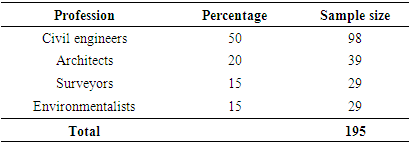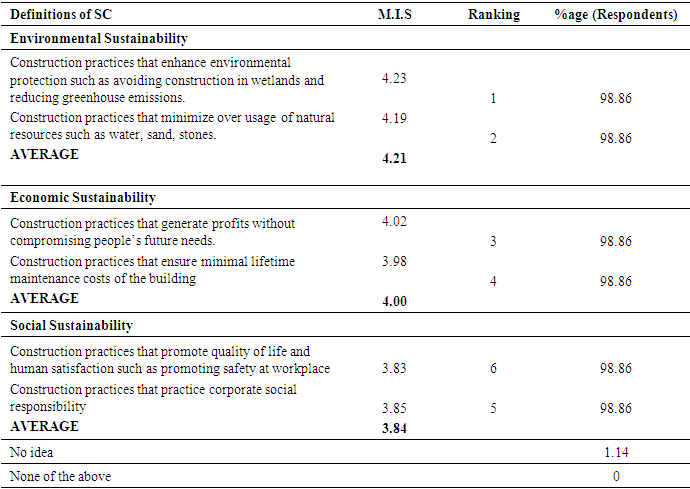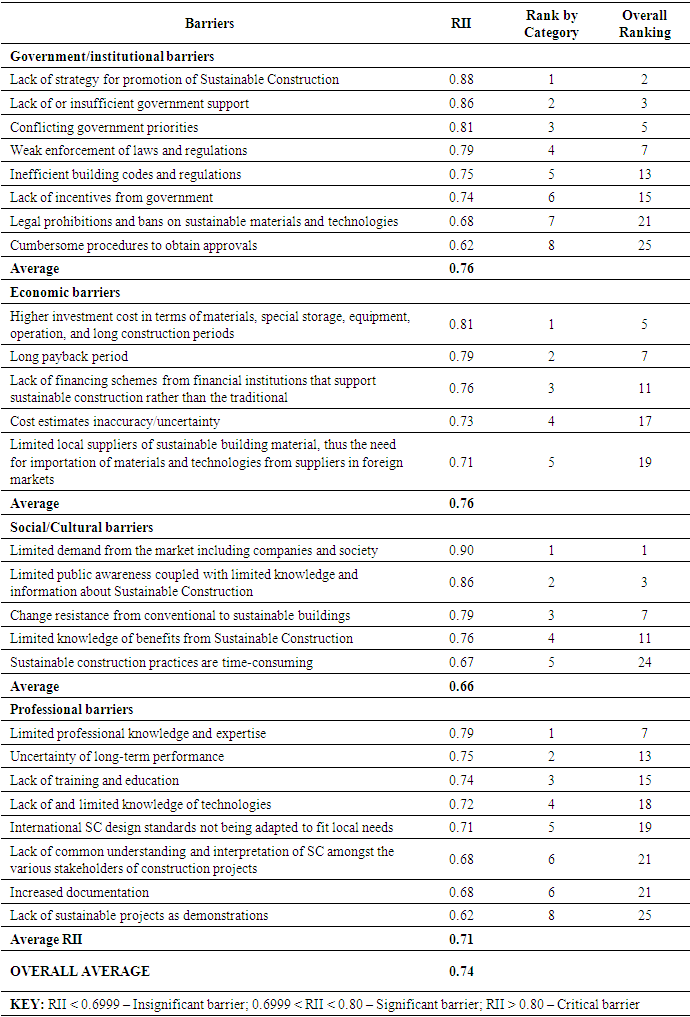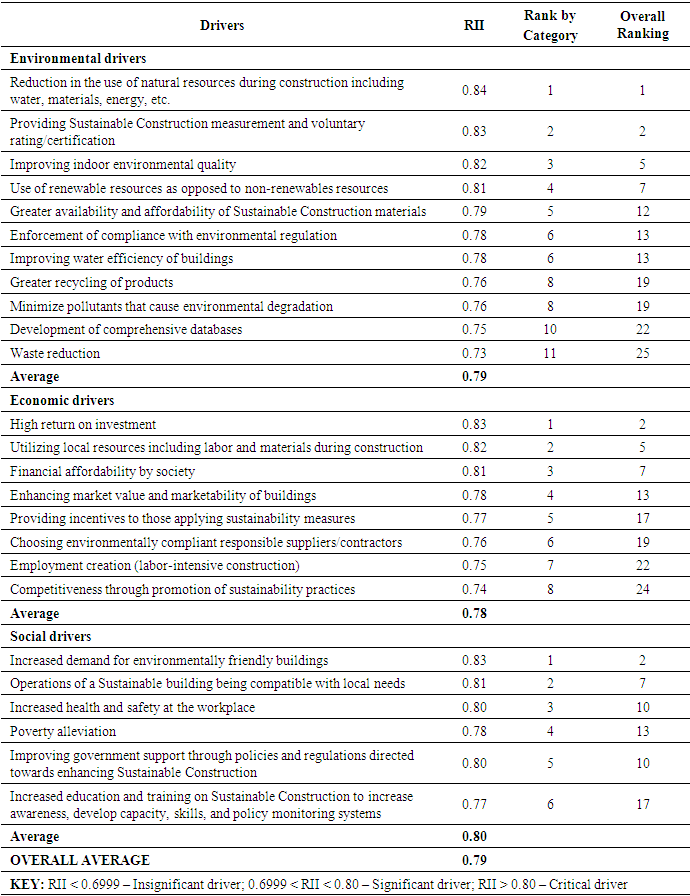-
Paper Information
- Paper Submission
-
Journal Information
- About This Journal
- Editorial Board
- Current Issue
- Archive
- Author Guidelines
- Contact Us
International Journal of Construction Engineering and Management
p-ISSN: 2326-1080 e-ISSN: 2326-1102
2025; 14(2): 61-72
doi:10.5923/j.ijcem.20251402.03
Received: Mar. 20, 2025; Accepted: Apr. 22, 2025; Published: May 17, 2025

An Investigation into the Barriers and Drivers of Sustainable Construction in Uganda
Duncan Lugya
Department of Civil and Environmental Engineering, Kyambogo University, Kampala, Uganda
Correspondence to: Duncan Lugya, Department of Civil and Environmental Engineering, Kyambogo University, Kampala, Uganda.
| Email: |  |
Copyright © 2025 The Author(s). Published by Scientific & Academic Publishing.
This work is licensed under the Creative Commons Attribution International License (CC BY).
http://creativecommons.org/licenses/by/4.0/

This study investigated the barriers and drivers to sustainable construction (SC) in Uganda, with the aim of developing a framework to promote its wider adoption. The construction industry has immensely contributed to the development of the economy. However, the impact to the environment arising from construction activities is significant. There is therefore a great need for identifying the barriers and drivers to SC in Uganda. A sample size of 173 construction professionals from Kampala and Wakiso were surveyed using questionnaires. The data collected were analyzed quantitatively using Statistical Package for Social Scientists (SPSS) and the RII of each variable was used to determine the most critical barriers and drivers. The findings revealed several barriers to SC, including limited market demand (RII: 0.90), limited public awareness about SC (RII: 0.86), lack of strategy for promotion of SC (RII: 0.88) among others. In terms of drivers, factors, such as reduction in natural resource use (RII: 0.84), providing SC measurement/rating (RII: 0.83) and higher return on investment (RII: 0.83) were found to motivate the adoption of SC. The study further assessed the level of awareness and interpretation of SC, highlighting the need for increased education on the benefits of SC. Based on the results, a framework was proposed, emphasizing the importance of government incentives, awareness campaigns, and collaboration with stakeholders. The study provides valuable insights for promoting the wider adoption of SC in Uganda and lays the groundwork for future research and policy development.
Keywords: Sustainable Construction, Barriers, Drivers, Awareness, Framework, Uganda
Cite this paper: Duncan Lugya, An Investigation into the Barriers and Drivers of Sustainable Construction in Uganda, International Journal of Construction Engineering and Management , Vol. 14 No. 2, 2025, pp. 61-72. doi: 10.5923/j.ijcem.20251402.03.
Article Outline
1. Introduction
- Construction activities have an environmental impact throughout the life of the building development [9]. The environmental impacts occur from the initial preparation works, through the period of constructing, operating, up to the last phase of demolition [3].The environmental effect of construction activities can be highlighted by being responsible for releasing 35–40% of CO2 into the atmosphere, exploiting 40% of construction inputs (raw materials), and utilizing 16% of water in construction and related activities worldwide [6].In Africa, in 2018, buildings contributed 61 percent of Africa’s final energy consumption and 32 percent of CO2 emissions [19]. In Uganda, large quantities of trees are harvested every year for use in construction activities, which leads to environmental degradation [18]. Developing countries like Uganda in tropical and subtropical areas will be hit the worst by the climate changes. The low level of awareness of environmental concerns makes the situation even more critical in these countries [7]. While many studies address environmental challenges in construction, research specifically focused on the Ugandan context is limited. According to Daniel et al., (2018) [4], SC has not received sufficient attention in Africa yet its an important aspect of sustainable development. According to Kibwami and Tutesigensi (2016) [11], integrating embedded carbon (EC) into the development approval process (DAP) for building projects in Uganda can improve sustainable construction. However, their research acknowledges that the specific factors that contribute to barriers to SC are not adequately addressed in the existing DAP. This means that while the EC analysis itself is beneficial, more work is needed to understand and address the root causes of why SC practices are not fully adopted in the Ugandan building sector. The negative impact to the environment by construction activities, is what motivated the researcher to investigate the barriers and drivers to SC in Uganda, with an aim of increasing its adoption. It is possible that the negative environmental effects could be reduced or eliminated if the construction industry adopts sustainable methods of construction [5]. Most African countries including Uganda are characterized by low adoption of SC practices [21]. Despite the existing reported studies on SC, the topic has not been given the attention it deserves within developing countries. Therefore, it is pertinent to establish the barriers hindering SC adoption in Uganda despite reported high levels of awareness amongst construction professionals, coupled with the drivers that can be relied on to promote its adoption.
2. Sustainable Construction
2.1. Definition
- The idea of “Sustainability” was first defined by the prime minister of Norway, Gro Brundtland, who authored the Brundtland Report, published by United Nations of the World Commission on Environment and Development in 1989. This report has been a central component of several studies and practices [20]. Brundtland defined sustainability as "leaving sufficient resources for future generations to have a quality of life similar to ours" [10]. Generally, sustainability refers to the use of natural resources in such a manner that they do not reach an unrenewable point, decay or depletion and ensuring that the next generations are not disadvantaged [20].Sustainability in construction can further be explained as the incorporation of sustainable development principles to construction [11]. It can also be defined as the application of sustainable development principles to the life cycle of a building from planning to demolition [20]. At the First International Conference on Sustainable Construction held in November 1994 in Tampa, Florida, USA, sustainable construction was defined as, “creating a healthy built environment using resource-efficient, ecologically-based principles” [8].
2.2. Pillars of Sustainable Construction
- Sustainable construction involves a commitment to:i) Social sustainability – being responsive to the needs of people at all stages of the construction process (from planning to demolition), working closely with all stakeholders (local communities, employees, suppliers, and clients) so as to ensure high customer satisfaction. Social sustainability focuses on ensuring a fair and inclusive society where everyone has the opportunity to thrive. Key principles include social equity, diversity and inclusion, democratic participation, livelihood security, and social well-being. These principles aim to create a just and equitable society where individuals and communities can flourish, while also preserving social cohesion and justice.ii) Economic sustainability – efficient utilization of resources including materials, labor, water and energy, thus leading to increased profitability.iii) Environmental sustainability – careful utilization of natural resources, enhancing and protecting the environment and minimizing waste, thus preventing irreversible effects to the environment [8].
2.3. Principles of Sustainable Construction
- There are six (6) principles of SC as reported by many researchers. These principles apply to the entire life span of a building, spanning from the planning phase to demolition. The principles further extend to the resources (ecosystems, building materials, land, energy, and water) required to create and operate the built environment during its whole life span [22]. These include;• Minimize resource consumption (Conserve) • Maximize resource reuse (Reuse)• Use renewable or recyclable resources (Renew/Recycle)• Create a healthy, non-toxic environment (non-toxics)• Protect the natural environment (Protect Nature)• Pursue quality in creating the built environment (Quality) [10]
2.4. Theories of Sustainable Development
- The theories of sustainable development include;The extinction avoidance theory of sustainable development is a framework that emphasizes the preservation of natural and man-made resources to prevent their depletion and eventual extinction. It argues that unsustainable practices can lead to the long-term disappearance of valuable resources, impacting both current and future generations.The collective stewardship theory of sustainable development proposes that humanity as a whole is responsible for safeguarding planet earth's resources and ensuring their responsible use for present and future generations. It emphasizes a collaborative and ethical approach to resource management, where individuals are seen as good stewards and are motivated to act in a way that benefits both the environment and society.The rogue agent theory of sustainable development posits that individuals or groups entrusted with managing resources may act against the interests of society and the environment, hindering sustainable development. The divine intervention and providence theory of sustainable development states that God through divine intervention or divine providence replenishes the natural resources which human beings cannot replenish, and human beings may or may not be aware of this divine intervention or divine providence.The resource-resilient world theory of sustainable development emphasizes that resources being depleted today are the very same resources needed to address future shocks and threats. It highlights the importance of resource management that not only meets current needs but also ensures their availability for future generations, promoting a balanced approach to economic, social, and environmental well-being [15].
2.5. Barriers to Sustainable Construction
- Barriers refer to obstructions or hindrances to an operation. They can also be referred to as situations that hinder actions and/or progress towards a particular goals or objectives [14]. Literature review revealed many barriers hindering the embracing of SC in developing countries, Africa and the world at large. For this study, the identified barriers in the literature review can generally be categorized as indicated below.
2.5.1. Government/Institutional Barriers
- Lack of or insufficient government support towards the promotion and adoption of SC is a great barrier to SC in developing countries. This is coupled with inefficient building codes and regulations, which mostly benefit conventional methods of construction as opposed to SC techniques. Legal prohibitions and bans on sustainable materials and technologies has also hindered SC adoption. Also, the weak enforcement of regulations and laws established to enforce the adoption of SC techniques has enabled developers to stick to conventional construction methods. Further still, there is no clear strategy for promotion of SC in many developing countries. Even when the developers choose to undertake SC techniques, the procedures to obtain the necessary approvals is cumbersome, thus forcing them to resort to conventional methods of construction. Furthermore, governments have not offered any incentives to developers as a means of enticing them towards SC. Finally, the conflicting government priorities including poverty eradication, education for all, health etc., has made SC a less priority as compared to others.
2.5.2. Economic Barriers
- SC is associated with higher investment cost in terms of materials, special storage, equipment, operation and long construction periods. Secondly, due to lack of familiarity, there are higher chances of cost estimates inaccuracy/ uncertainty which might lead to losses. Also, the benefits of SC are not instant. The long payback period has also proven to be a barrier to SC. Furthermore, the lack of financing schemes from financial institutions to support SC has also barred developers from adopting it. Finally, there are limited local suppliers of sustainable building material thus the need for importation of materials from foreign markets.
2.5.3. Social/Cultural Barriers
- The limited public awareness coupled with limited knowledge and information about SC has hindered it adoption. This is coupled with the limited demand from the market including companies and society. Further still, change resistance from conventional to sustainable buildings by the various stakeholders has further become a barrier to its adoption. The limited knowledge of benefits SC practices has also made the developers reluctant to adopt it.
2.5.4. Professional Barriers
- The limited professional knowledge and expertise on SC amongst the construction professionals is a barrier to its adoption. This is coupled with a lack of and limited knowledge of technologies used in SC. Further still, the increased documentation that comes along with SC practices has also hindered its adoption. The lack of projects executed using SC techniques to serve as demonstrations to the construction professionals has also hindered its adoption. The lack of demonstrations has further created an uncertainty of long-term performance of sustainable projects. Also, the lack of necessary reference database and information on SC to offer guidance to the professionals during design and execution of sustainable projects has made it hard to adopt the concept. inadequate training and education International SC design standards not being adapted to fit local needs.
2.6. Drivers to Sustainable Construction in Uganda
- Drivers can be defined to be practices that when implemented can stimulate the promotion of SC practices. They include the possible gains, actions and resolutions that entice stakeholders into implementation of SC [13]. In this study, the drivers to Sustainable Construction have been categorized into environmental, economic and social barriers.
2.6.1. Environmental Drivers
- The ability of SC to cause a reduction in the utilization of natural resources including water, materials, energy etc. can be a great factor that drives construction professionals towards adopting SC. This is coupled with its ability to allow for the recycling and re-use of products to avoid wastage and reduce wastes arising from construction projects, improving indoor environmental quality and improving the water efficiency of buildings in terms of usage. The use of renewable resources as opposed to non-renewables resources to prevent depletion can also drive masses towards SC. Also, the ability to minimize pollutants that cause environmental degradation, during and after construction was identified as one of the drivers to SC. Providing Sustainable Construction measurement and voluntary rating/ certification as a means of measuring the sustainability of each construction project will force developers into sustainability. The greater availability and affordability of Sustainable Construction materials on our local markets will also drive professionals towards sustainability. Also, the development of comprehensive data bases to offer guidance and create a reference to professionals during design and project implementation will enable them to adopt SC practices. Finally, the enforcement of compliance of established environmental regulations geared towards ensuring sustainability is a great driver to SC.
2.6.2. Economic Drivers
- The economic drivers to SC include; the financial affordability of sustainable projects by the society, the ability of sustainable projects to create employment opportunities to the local population, the ability of SC techniques to enhance the market value and marketability of buildings and thus influencing a high return on investment. This is coupled with choosing environmentally compliant responsible suppliers/contractors during the procurement process so as to put them at advantage over other conventional contractors, providing incentives in terms of tax holiday, cash incentives etc. to those applying a sustainability measure and utilizing local resources including labor and materials during construction.
2.6.3. Social Drivers
- The ability of SC to cause poverty alleviation through the creation of employment opportunities, increased income, etc. can be an effective driver towards SC. This coupled with increased health and safety at workplace, operations of a sustainable buildings being compatible with the local needs of the society and ensuring an increased demand for environmentally friendly buildings through sensitization of the developers concerning the benefits of sustainable buildings. This can be achieved through increased education and training to construction professionals on SC to increase awareness, developing capacity, skills and policy monitoring systems to ensure compliance. Finally, improving government support through establishing policies and regulations directed towards enhancing SC can also drive the population towards SC.
3. Methodology
3.1. Population Characteristics
- The population comprised of professionals (architects, engineers, surveyors and environmentalists) in the construction industry. These professionals are responsible for making decisions and implementing the activities in construction projects. This implies that they have a high knowledge of the realities on ground, cultures, standards and practices that are commonly utilized in the industry in Uganda. This means a very important asset in establishing practical and efficient drivers and barriers to SC [17].Both non-probability and probability sampling techniques were adopted in establishing a sample to ensure that it was representative of the targeted population. In probability sampling technique, stratified sampling was used to select samples from each stratum, a professional body i.e. Uganda Society of Architects (USA), Uganda Institute of Professional Engineers (UIPE), Institute of Surveyors of Uganda (ISU) and National Association of Private Environmentalists (NAPE) to ensure that all construction professionals were well represented and then simple random sampling was conducted on the stratified samples so that every member in the stratified sample gets a chance to be selected. In non-probability sampling, specifically purposive sampling was employed, where members/samples were selected from the selected organizations and projects in the study area for a specific purpose.In obtaining the sample size of participants, the equation which gave a scientific procedure for determining sample size was used. The equation was stated below:
 | (1) |
|
3.2. Choice of Study Area
- The study was implemented in Uganda, with particular emphasis on areas within Kampala Capital City Authority and Wakiso District Local Government. This is because these areas currently have a high concentration of multi-million construction projects as compared to other parts of the country by both government agencies and private developers.
3.3. Data Analysis
- Data was obtained over a period of four months through face-to-face structured questionnaires and interview guides to obtain the information relevant to this study. Questionnaires were distributed to respondents, with collection occurring at a later date.The data and responses from observations and interviews were summarized and analyzed to create a list of barriers and drivers to SC for making questionnaires together with data from literature review. The filled questionnaires were collected, checked for accuracy, consistency and completeness before leaving the field. Raw data was then analyzed quantitatively using statistical analysis using Statistical Package for Social Scientists (SPSS) and MS Excel.The first section of the questionnaire aimed at investigating the level of awareness and interpretation of SC in Uganda. It had various interpretations or definitions of SC. The respondent was required to express his or her level of agreement with each of the definitions on a likert scale of 1 to 5. Options for “no idea” and “none of the above” were also included for purposes of identifying participants with no awareness of SC. The percentage of responses corresponding to the “no idea” and “none of the above” options gave an indication of the level of awareness of SC of the participants. Interpretation of SC by participants was obtained by calculating the Mean Item Score (M.I.S) of each of the definitions or interpretations using the equation by Tholibon et.al., (2021) [16];
 | (2) |
 | (3) |
4. Presentation and Discussion of Research Findings
4.1. Level of Awareness and Interpretation of SC in Uganda
- The first objective was to establish the level of awareness and interpretation of sustainable construction in Uganda. The research undertaken established that there was high level of awareness of SC in Uganda. Out of the 175 questionnaires that were returned, only two of the participants representing 1.14% indicated that they had no idea about the concept of SC. This implied a 98.86% awareness of the concept of SC amongst the participants, thus a high level of awareness. This finding is in line with a study carried out in Uganda by Kibwami and Tutesingesi, (2016) [11], which reported that 100% of the participants in that study had an idea about the concept SC, though in varying levels. In a similar study carried out in Kuwait, 100% of the respondents had awareness about the concept of SC [1]. In Ghana, 83% level of awareness was reported by Ametepey et.al. (2015) [2]. From the summary of results in table 2, it can be observed that the highest number of respondents interpreted SC in terms of environmental sustainability (Average M.I.S = 4.21), followed by economic sustainability (Average M.I.S = 4.00), and lastly social sustainability (Average M.I.S = 3.84). This suggests that respondents highly interpret SC to mean environmentally-friendly construction practices and their role in mitigating environmental impacts. The implication is that there is a foundation for promoting sustainable construction practices in Uganda, particularly in terms of environmental protection.
|
4.2. Barriers to Sustainable Construction
- The second objective was to determine the barriers to sustainable construction in Uganda. From the summary of results in table 3, it can be observed that government/institutional barriers and economic barriers ranked as the top most barriers to SC with an average RII of 0.76, followed by professional barriers (RII = 0.74) and social/cultural barriers (RII = 0.66).
|
|
4.3. Drivers to Sustainable Construction in Uganda
- The third objective was to determine the barriers to SC in Uganda. Environmental Drivers:The study established that environmental drivers ranked overall second amongst the drivers to SC in Uganda with an average RII of 0.79. From the summary of results, it can be observed that the critical environmental drivers were; reduction in the use of natural resources during construction including water, materials, energy, etc. (RII = 0.84), providing SC measurement and voluntary rating/certification (RII = 0.83), improving indoor environmental quality (RII = 0.82), use of renewable resources as opposed to non-renewables resources (RII = 0.81). The study further revealed that greater availability and affordability of SC materials, enforcement of compliance with environmental regulation, improving water efficiency of buildings, greater recycling of products, minimizing pollutants that cause environmental degradation, development of comprehensive databases, and waste reduction as significant barriers to SC in Uganda.Economic driversThe study also established that economic drivers ranked third overall amongst the drivers to SC in Uganda. The summary of results revealed that the critical economic drivers were; high return on investment (RII = 0.83), utilizing local resources including labor and materials during construction (RII = 0.82) and financial affordability by society (RII = 0.81). The study further revealed that enhancing market value and marketability of buildings, providing incentives to those applying sustainability measures, choosing environmentally compliant responsible suppliers/contractors, employment creation (labor-intensive construction) and competitiveness through promotion of sustainability practices are significant environmental drivers.Social driversThe research also established that social drivers ranked first amongst the drivers to SC in Uganda with an average RII of 0.80. The summary of results revealed that the critical social drivers were; increased demand for environmentally friendly buildings (RII = 0.83), operations of a sustainable building being compatible with local needs (RII = 0.81), increased health and safety at the workplace (RII = 0.80), improving government support through policies and regulations directed towards enhancing SC (RII = 0.80). The study further revealed that poverty alleviation and increased education and training on SC to increase awareness, develop capacity, skills, and policy monitoring systems were significant drivers.
4.4. Framework to Promote Wider Adoption of SC in Uganda
- The study also set out to develop a framework for the promotion of a wider adoption of SC in Uganda. The critical barriers and drivers as revealed by the study were used as the basis for developing a framework for promotion of wider adoption of SC in Uganda. The framework in figure 1 aims to arrange the ‘‘organizational environment” in which construction activities are carried out, re-define the roles of those involved in these projects, and enhance their capacities to enable them achieve the common objectives of raising the efficiency of construction projects from three aspects of economy, environment, and function.
4.4.1. Operationalization of the Framework
- The operationalization of this framework shall be undertaken at three levels of implementation namely; National level, institutional level and the executive level. Various efforts aimed at eliminating or minimizing the identified critical barriers whilst achieving the critical drivers identified in the study, shall be made at each of the three levels, with a general goal of ensuring a wider adoption of SC in Uganda. Each of the three levels will work together in a coordinated manner to ensure alleviation or promotion of the critical barriers and drivers respectively.
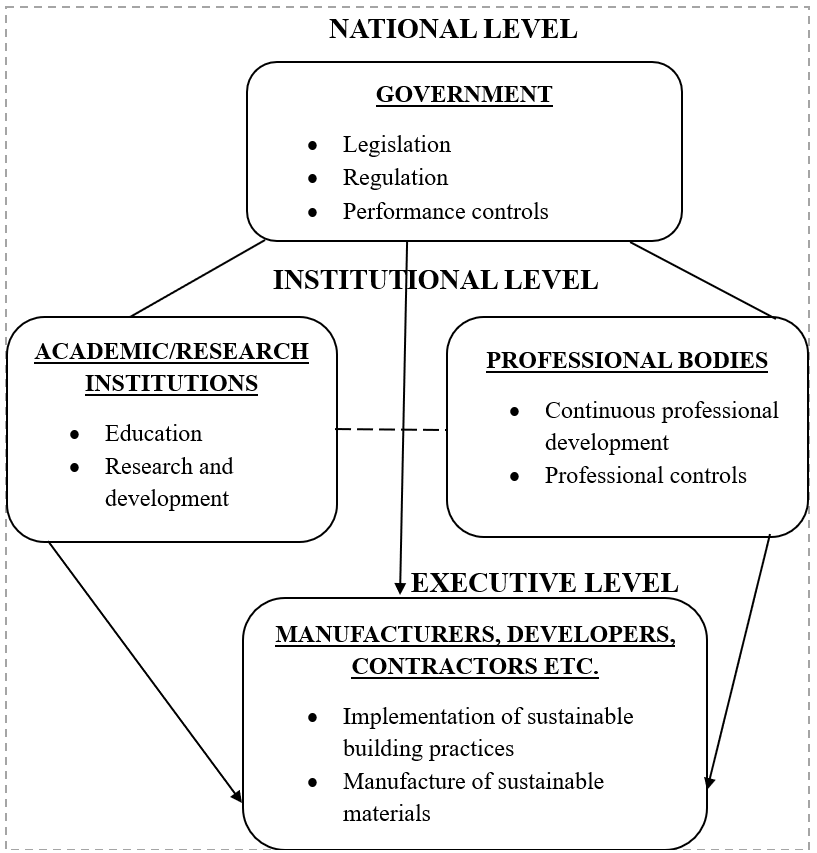 | Figure 1. Framework to promote the adoption of SC in Uganda |
4.4.2. National Level
- Figure 1 shows that the solution starts at the national level, where the government with its various institutions of governance (parliament, police, local administrative units, government corporations, ministries, etc.) need to play a very important role in ensuring the achievement of the identified critical drivers to SC whilst alleviating the critical barriers.The national mechanism should play the following regulatory and normative roles;• Government should develop the necessary legal framework and infrastructure to achieve SC. • The government should establish professional standards and ethics for sustainable projects to ensure responsible implementation and foster public trust.• Government should provide support through incentives, favorable policies, subsidies, faster approval processes for proposed sustainable projects etc.• Give tax and financial incentives to material suppliers, developers and contractors undertaking sustainable projects. • Government should develop a SC measurement and voluntary rating mechanism for all construction projects. • Government should exert restrictions on the percentages of imported labor and materials to be used on a particular project.• Government should exert penalties on violators of sustainable construction principles.
4.4.3. Institutional Level
- At the institution level, two categories of sectors are required to work in an integrated manner to ensure the implementation of sustainable building practices. The first of these sectors are the academic and research institutions including universities, colleges etc. The second sector is the professional bodies including UIPE, ISU, USA, NAPE, UNABCEC etc. These institutions will play the following roles; • Carry out research aimed at developing effective strategies for promotion of SC, identifying alternative natural resources, sustainable building design etc.• Streamline their academic curriculum to focus on offering adequate training and awareness of SC to learners. • Professional bodies should also organize regular continuous development trainings for their members aimed at bridging the knowledge gap on SC.• Professional bodies should exert pressure onto their members i.e. contractors, project managers, developers, architects etc. to adopt SC techniques in all their operations including design, construction, operation etc. in line with the established legal framework.
4.4.4. Executive Level
- At the third level is the executive level which includes the private sector e.g. manufacturers, contractors, developers etc. The roles played by the government and institutions will drive the executive sector to play the following roles;• Undertake the implementation of sustainable building practices.• Manufacture and supply cheap sustainable materials leading to a reduction in investment costs of sustainable projects.• Increase demand by activating the market movement to cause demand for environmentally friendly buildings. • Commit to the use of renewable resources and effect a reduction in the use of natural resources.• Commit to employing a specified percentage of local labor and utilizing more local construction materials as opposed to imported materials.
4.5. Conclusions and Recommendations
- ConclusionsThe study on sustainable construction in Uganda reveals important findings that can guide efforts to promote its wider adoption. The level of awareness of SC amongst construction professionals in Uganda is high at 98.16%. However, the professionals widely interpreted the concept of SC as synonymous with environmental sustainability. This is because the statements that described SC in line with environmental sustainability received the highest mean score. This was followed by statements that described SC in line with economic sustainability and lastly, social sustainability. The study concludes therefore that there is a high level of awareness of SC in Uganda. Although this does not directly translate into a high level of SC practices, it indicates that initiatives aimed at promoting SC can easily be appreciated.The study further identified the critical barriers to SC. These include limited demand from the market, lack of strategy to promote SC, lack of government support, insufficient awareness and understanding, higher initial costs, and conflicting government priorities. The study thus concludes that to ensure wide adoption of sustainable construction in Uganda, there is a great need to alleviate or minimize the identified critical barriers. This can be achieved through increased government involvement, policy reforms, and awareness campaigns. Economic barriers also need to be addressed through cost-effective alternatives and innovative financing mechanisms.On the other hand, the study identified several critical drivers that can facilitate the adoption of sustainable construction practices. These include the reduction in the use of natural resources, high return on investment, improving indoor environmental quality, use of renewable resource, providing sustainable construction measurement and certification, utilizing local resources, financial affordability, increased demand, operations of sustainable buildings being compatible with local needs, and high return on investment contribute to the promotion of sustainable construction. The study thus concludes that efforts made to capitalize on the above drivers can go a long way in enhancing the adoption of SC in Uganda.A framework arising from the above study findings was developed. This highlighted the institutions and stakeholders, plus the roles to be played by each stakeholder at various levels, including national, institutional and executive levels. The study thus concludes that adopting the development framework will lead to a wider adoption of SC in Uganda.RecommendationsFrom the above conclusions, the study makes the following recommendations;(i) Due to the fact that a number of professionals largely interpreted sustainable construction in terms of environmental sustainability, this should serve as an entry point for the promotion of sustainable construction in Uganda. To achieve this, the existing environmental policy framework, such as the National Environmental Act and the Environmental Impacts Assessment regulations, can be used.(ii) Collaboration and Partnerships: Collaboration between government agencies, industry associations, professional organizations, and other stakeholders is essential for promoting sustainable construction. Establishing platforms for knowledge-sharing, networking, and collaboration can facilitate the exchange of best practices, experiences, and lessons learned. Joint initiatives and partnerships can also be formed to address common challenges and promote sustainable construction across the industry.(iii) The findings of this study can only offer a foundation for further studies into this topic. This is because the data collected was only from construction professionals majorly around Kampala and Wakiso. Data and opinions form other stakeholders and other major parts of the country are also necessary. This can be something to consider in further studies.
 Abstract
Abstract Reference
Reference Full-Text PDF
Full-Text PDF Full-text HTML
Full-text HTML